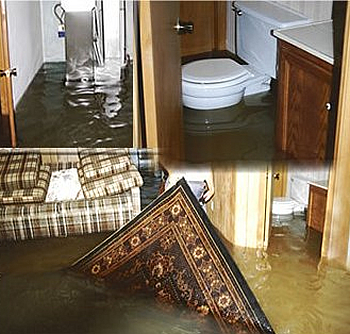Quick Action Can Help You Save Water-Damaged Washables
Clothes and other washables that are subjected to floods or other water damage can often be saved if you act quickly. Even water that appears to be "clean" contains bacteria, which must be removed immediately. If the water damage also includes other contaminants, such as mud or soil, there are other steps that must be taken to prevent further damage.
Sorting, Washing, Drying - Not Your Normal Laundry Day
Soiled items must first be sorted as soon as possible into two groups, whites and colors. When the items are wet, it is important to avoid leaving colored clothing mixed with whites, because the coloring dyes can transfer to the white items and stain them.
It’s also important to avoid sorting wet, contaminated items on any surfaces where bacteria can be spread and contaminate clean items. Clean every surface that comes in contact with the contaminated clothing. Dirty, contaminated clothing and other washables that cannot be cleaned immediately should be spread out and allowed to dry individually, if necessary. Don’t leave them in a wet pile, and don’t store them in a plastic bag. That encourages mildew growth and staining.
If the washable items are contaminated with mud or soil, rinse off the material as thoroughly as possible with a hose before washing. Items that are mud-covered may overwhelm the washing machine’s drainage system. The last thing you want is a washing-machine overflow.
If the soil in the flood waters is high in iron content, chlorine bleach can cause rust spots to appear on clothing. Separate treatment will be needed to remove the rust stains.
Be sure to consult the care instructions on the items, if they are there. Wash the clothes in the hottest water recommended for the fabric.
Disinfecting is Key to Restoring Clothing After a Flood
To disinfect, for white cotton fabrics, add one cup chlorine bleach in the wash cycle. For fabrics that cannot be washed with chlorine bleach, such as spandex, wool, silk, or colored clothes, add one cup of pine oil disinfectant such as Pine-Sol or one cup of phenolic disinfectant such as Lysol to the wash. If stains are evident after washing the items, do not dry them. That could lock in the stains. Soak the stained items overnight in a solution of oxygen-based bleach and then wash with regular laundry detergent.
Dry clothing in a dryer at the highest heat recommended for the clothing to help kill bacteria. White clothes can also be hung outside in the sun where, ultraviolet rays will help kill bacteria.
If your washer has been contaminated with flood waters, it should be cleaned and disinfected before using. It should also be checked by a technician to be sure it is safe to use.
Taking these simple precautions may help you save your valuable and favorite clothing from being tossed in the dumpster after a flood or water damage.
- Back to articles list.
- Contact us now to begin the remediation and restoration process.
- Discover why you should work with the professionals at McClincy's




